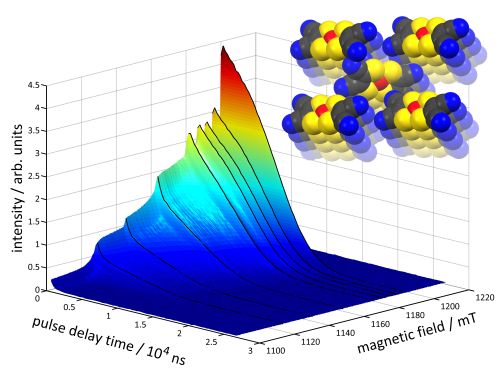Molecular Quantum Bit with Long Coherence Time Discovered in Stuttgart

Qubit structure (top right) and three-dimensional representation of coherence decay curves. University of Stuttgart
From more efficient database queries to the cracking of today's reliable cryptographic systems: The development of a competitive quantum computer would mark the beginning of a new digital era. So far research is focused on finding suitable processing units, the so-called quantum bits (qubits). In contrast to classical bits, they cannot only be in the states 0 and 1, but also in an arbitrary superposition of those two states. A prerequisite for useful computations is a long coherence time (life time) of the superposition states. Prof. Joris van Slageren´s research group at the Institute of Physical Chemistry, University of Stuttgart recently published results on a coordination compound with exceptionally long coherence times over an unusually wide temperature range in Nature Communications.
Bader, K. et al. Room temperature quantum coherence in a potential molecular qubit. Nat. Commun. 5:5304 doi: 10.1038/ncomms6304 (2014).
Recently, many different systems have been proposed for the physical implementation of a quantum bit. Very promising proposals utilize the electron spin in magnetic molecules.
Of these, coordination compounds consisting of a metal ion with organic groups (ligands) offer the advantage of the realization of tailor-made physical properties via convenient chemical manipulations.
A well-known limiting factor for the life time of the superposition state is the presence of adjacent nuclear spins, as they generate stray fields. Based on this knowledge the Van Slageren group identified a compound containing very few nuclear spins in vicinity of the electron spin as potential candidate for showing long coherence times.
The compound consists of a central copper ion incorporated in an organic shell with only few nuclear spin carrying elements. Additionally, the ligand shell is very flat and rigid which enables the compound to form stable columns in the solid state.
The measurements of Van Slageren´s research group proved that these design-criteria indeed enable exceptionally long coherence times. At low temperatures (7 Kelvin) a coherence time of 68 microseconds was observed. This substantially exceeds previous reported values for molecular compounds, which were around a few microseconds.
Astonishingly, the Stuttgart researchers were able to detect coherence over an unusually wide temperature range. So far molecular qubits only showed coherence at very low temperatures, whereas the introduced compound´s coherence is room-temperature stable. With this property, the realization of energy efficient quantum computers with low operating expenses moves closer.
The next challenge on the way towards a working quantum computer is the structured deposition of the compound on surfaces, which will be tackled now by the Stuttgart researchers. “In order to construct a quantum computer it´s not only necessary to identify compounds with long coherence times, but also to find a possibility for selectively addressing them” says Ph.D.-student Katharina Bader.
The work is part of her doctoral dissertation, which is supported by “Fonds der Chemischen Industrie”. The measurements were performed in cooperation with Goethe University Frankfurt and were financially supported by “Deutsche Forschungsgemeinschaft” and “Center for Integrated Quantum Science and Technology (Stuttgart/Ulm)”.
Further Information:
Prof. Joris van Slageren, Universität Stuttgart, Institut für Physikalische Chemie, Tel. 0711/685-64380,
E-Mail: slageren (at) ipc.uni-stuttgart.de
Andrea Mayer-Grenu, Universität Stuttgart, Abt. Hochschulkommunikation, Tel. 0711/685-82176,
E-Mail: andrea.mayer-grenu (at) hkom.uni-stuttgart.de
Media Contact
More Information:
http://www.uni-stuttgart.de/All latest news from the category: Information Technology
Here you can find a summary of innovations in the fields of information and data processing and up-to-date developments on IT equipment and hardware.
This area covers topics such as IT services, IT architectures, IT management and telecommunications.
Newest articles

Combatting disruptive ‘noise’ in quantum communication
In a significant milestone for quantum communication technology, an experiment has demonstrated how networks can be leveraged to combat disruptive ‘noise’ in quantum communications. The international effort led by researchers…

Stretchable quantum dot display
Intrinsically stretchable quantum dot-based light-emitting diodes achieved record-breaking performance. A team of South Korean scientists led by Professor KIM Dae-Hyeong of the Center for Nanoparticle Research within the Institute for…

Internet can achieve quantum speed with light saved as sound
Researchers at the University of Copenhagen’s Niels Bohr Institute have developed a new way to create quantum memory: A small drum can store data sent with light in its sonic…





















